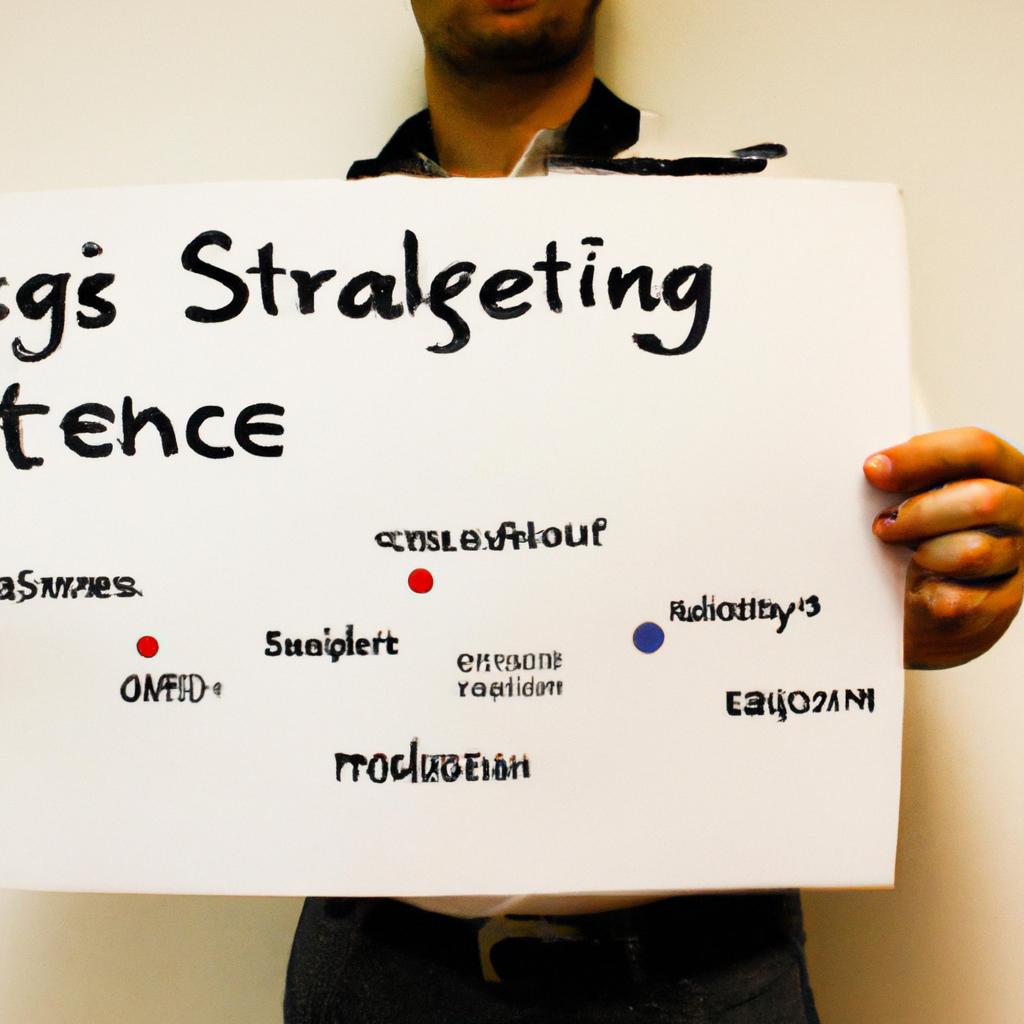Social media has revolutionized the way businesses promote their products and services, allowing for more targeted and interactive marketing campaigns. In recent years, social media platforms have become essential tools for marketers to reach a wider audience and engage with potential customers in a more personalized manner. This article aims to explore the concept of social media campaigns in marketing, shedding light on various promotional strategies employed by companies to achieve their objectives.
One prime example that highlights the effectiveness of social media campaigns is the case of XYZ Company. By leveraging popular platforms such as Facebook, Twitter, and Instagram, XYZ Company successfully increased its brand awareness and customer engagement. Through creative content creation and strategic targeting, they were able to generate significant buzz around their product launch, resulting in an increase in sales and overall business growth. This success story serves as evidence of how well-executed social media campaigns can effectively enhance marketing efforts.
In this article, we will delve deeper into the world of social media campaigns in marketing, exploring different approaches used by companies across industries. From influencer collaborations to user-generated content initiatives, we will examine how these strategies aim to captivate audiences, build brand loyalty, and ultimately drive conversions. By understanding the underlying principles behind successful social media campaigns, marketers can harness the power of these digital platforms to achieve their marketing goals.
One of the key elements of a successful social media campaign is content creation. Marketers must create engaging and shareable content that resonates with their target audience. This can be done through various formats such as videos, images, blog posts, infographics, or even interactive quizzes. The content should be tailored to the platform it will be shared on and should align with the brand’s messaging and values.
Another important aspect of social media campaigns is strategic targeting. Marketers need to identify their target audience and understand their preferences, interests, and behaviors. By utilizing data analytics tools available on social media platforms, marketers can gather valuable insights about their audience and tailor their campaigns accordingly. This includes selecting the right keywords, hashtags, or demographics to reach the desired audience effectively.
Influencer collaborations have also become a popular strategy in social media campaigns. By partnering with influencers who have a large following and influence over their followers’ purchasing decisions, brands can tap into an existing audience that is likely to be interested in their products or services. Influencers can help create authentic and relatable content that resonates with their followers, thereby increasing brand awareness and driving engagement.
User-generated content initiatives are another effective approach in social media campaigns. By encouraging users to create and share content related to the brand or its products/services, companies can foster a sense of community and build trust among their customers. User-generated content not only provides social proof but also allows for increased organic reach as users share their experiences with others.
Measurement and analysis are crucial components of any social media campaign. It is essential to track key performance indicators (KPIs) such as engagement rate, click-through rate (CTR), conversion rate, follower growth rate, etc., to evaluate the success of a campaign. This data can then be used to optimize future campaigns by identifying what worked well and what needs improvement.
In conclusion, social media campaigns have revolutionized the way businesses promote their products and services. Through strategic targeting, content creation, influencer collaborations, user-generated content initiatives, and effective measurement and analysis, companies can leverage the power of social media to reach a wider audience, engage with potential customers on a more personal level, and ultimately achieve their marketing objectives.
Understanding the Importance of Social Media Campaigns
In today’s digital age, social media campaigns have become an integral part of marketing strategies for businesses across various industries. These campaigns leverage the power of platforms such as Facebook, Instagram, and Twitter to engage with potential customers on a large scale. To illustrate this point, let us consider a case study of Company X, which successfully utilized a social media campaign to launch their new product line. Through strategic planning and execution, Company X experienced a significant increase in brand awareness and customer engagement.
One key reason why social media campaigns are crucial is their ability to reach a vast audience quickly and effectively. With millions of active users on these platforms, businesses can tap into a diverse pool of potential customers who may not be accessible through traditional advertising channels alone. Moreover, by using targeted advertisements and sponsored posts, companies can tailor their content specifically towards individuals who fit within their desired demographic profile.
To further emphasize the impact of social media campaigns, here are four benefits they offer:
- Increased brand visibility: By regularly posting engaging content and interacting with followers, businesses can enhance their brand presence online.
- Improved customer engagement: Social media allows for two-way communication between businesses and consumers, fostering meaningful interactions that strengthen relationships.
- Enhanced market research capabilities: Through data analysis tools provided by social media platforms, companies can gain insights into consumer preferences and behaviors.
- Cost-effective promotional strategy: Compared to traditional advertising methods like print or television ads, social media campaigns often yield higher returns on investment while being more budget-friendly.
Additionally, it is worth noting how varied elements within a successful social media campaign work together synergistically. Below is an example table outlining different components that contribute to its success:
| Component | Description | Benefit |
|---|---|---|
| Captivating Content | Engaging posts that resonate with target audience | Higher user interaction |
| Influencer Partnerships | Collaborations with social media influencers | Extended reach and credibility |
| Strategic Timing | Posting content during peak user activity times | Increased visibility |
| Data Analytics | Utilizing analytics tools to track campaign success | Informed decision-making |
In summary, social media campaigns are essential for modern-day marketing strategies due to their ability to connect businesses with a vast audience quickly and cost-effectively. By leveraging captivating content, influencer partnerships, strategic timing, and data analytics, companies can maximize the impact of their campaigns. With this understanding in mind, let us now delve into the next section: Identifying Target Audience and Setting Campaign Objectives.
Identifying Target Audience and Setting Campaign Objectives
Understanding the Importance of Social Media Campaigns has shed light on how businesses can harness the power of social media to promote their products or services effectively. Now, let us delve into another crucial aspect of running successful campaigns: identifying the target audience and setting campaign objectives.
Targeting an appropriate audience is vital for maximizing the impact of a social media campaign. For instance, consider a hypothetical scenario where a cosmetics company wants to launch a new line of skincare products primarily targeting women aged 25-35 with specific skin concerns such as acne and aging. By precisely defining this audience segment, the company can tailor its content and promotional strategies accordingly, ensuring that they resonate with potential customers.
To drive more engagement and create emotional connections with the target audience, marketers employ various strategies:
- Storytelling: Narrating compelling stories through social media posts helps evoke emotions in viewers and creates relatability.
- User-generated content (UGC): Encouraging users to share their experiences using hashtags or participating in challenges fosters a sense of community while promoting brand loyalty.
- Influencer partnerships: Collaborating with influential personalities aligns brands with trusted individuals who have already built credibility among their followers.
- Interactive elements: Incorporating quizzes, polls, contests, or interactive videos encourages active participation from the audience.
In addition to these strategies, creating buyer personas—a fictional representation of ideal customers—can assist marketers in understanding their target audience’s needs, preferences, and pain points better. This information then guides the development of effective campaign objectives. These goals should be SMART (Specific, Measurable, Achievable, Relevant, Time-bound), enabling companies to track progress accurately and assess campaign success against predetermined metrics.
By identifying the target audience comprehensively and setting clear campaign objectives aligned with customer insights, businesses increase their chances of achieving desired outcomes. The next step involves crafting engaging and shareable content that captivates the audience’s attention, which we will explore in the subsequent section.
[Transition sentence]: Now let us shift our focus to Crafting Engaging and Shareable Content.
Crafting Engaging and Shareable Content
Crafting engaging and shareable content plays a crucial role in the success of social media campaigns. By creating content that resonates with their target audience, marketers can increase brand awareness, drive user engagement, and ultimately achieve their campaign objectives. To illustrate this point, let’s consider the case study of Company X, an e-commerce retailer specializing in sustainable fashion.
To captivate their audience and encourage sharing, Company X implemented several strategies when crafting their social media content:
- Storytelling: They leveraged compelling narratives to connect emotionally with their audience. For instance, they shared stories about artisans behind each product, highlighting the positive impact on local communities and the environment.
- Visual Appeal: Recognizing the power of visuals in capturing attention, Company X invested in high-quality imagery and videos. These visually appealing assets not only showcased their products but also conveyed a lifestyle and values aligned with their target audience.
- Interactive Elements: To enhance user engagement, interactive elements such as polls or quizzes were incorporated into their posts. This encouraged users to actively participate, fostering a sense of connection with both the brand and other consumers.
- User-Generated Content (UGC): Encouraging customers to contribute UGC helped create a community around Company X’s brand. Sharing customer photos featuring their products built trust among potential buyers while providing free promotion for the company itself.
By employing these tactics consistently across various social media platforms, it is evident that Company X successfully created engaging and shareable content that resonated with their target audience.
| Key Strategies for Creating Engaging Content | Examples |
|---|---|
| Utilize storytelling techniques | Share personal anecdotes |
| Incorporate visually appealing images/videos | Showcase product benefits |
| Include interactive elements | Conduct polls/quizzes |
| Encourage user-generated content | Feature customer photos |
Overall, crafting engaging and shareable content is a vital step in social media campaigns. By employing strategies like storytelling, visual appeal, interactive elements, and user-generated content, marketers can effectively connect with their target audience and foster engagement. The next section will explore another powerful technique for amplifying reach: utilizing influencer marketing.
Harnessing the influence of individuals who have built substantial online followings can significantly boost campaign reach and impact. In the subsequent section, we will delve into the world of influencer marketing and its potential to elevate social media campaigns.
Utilizing Influencer Marketing to Amplify Reach
In a world where attention is constantly divided among various digital platforms, crafting engaging and shareable content has become crucial for successful social media campaigns. By capturing the interest of target audiences and encouraging them to share the content with their networks, businesses can significantly amplify their reach and maximize campaign effectiveness.
To illustrate this point, let us consider an example: Company XYZ recently launched a new line of eco-friendly products aimed at environmentally conscious consumers. In order to increase awareness and generate buzz around their brand, they created a series of visually stunning infographics highlighting the benefits of sustainable living. These infographics were not only informative but also aesthetically appealing, making it more likely for users to engage with and share them on social media platforms.
There are several key strategies that businesses can employ when crafting engaging and shareable content:
-
Storytelling: Telling compelling stories through your content helps create an emotional connection with your audience. Incorporating real-life examples or relatable narratives can evoke empathy or inspire action.
-
Visual Appeal: Utilizing eye-catching visuals such as images, videos, or graphics enhances the overall appeal of the content. People are more likely to engage with visually stimulating material, leading to higher sharing rates.
-
Humor: Injecting humor into your content can make it entertaining and memorable. Funny posts often have high viral potential as people enjoy sharing things that bring laughter to others.
-
User-generated Content (UGC): Encouraging users to contribute their own content related to your brand or campaign fosters engagement and increases authenticity. UGC provides social proof and creates a sense of community around your brand.
Engaging and shareable content plays a vital role in attracting attention and driving user interaction on social media platforms. By following these strategies, businesses can optimize their chances of creating impactful campaigns that resonate with their target audience.
Transitioning seamlessly from discussing the importance of crafting engaging and shareable content, the next section will delve into utilizing influencer marketing to amplify reach. By leveraging influential individuals in your industry or niche, businesses can tap into their established audiences and further enhance campaign effectiveness. Measuring and analyzing campaign performance is a crucial step in evaluating the success of social media campaigns and optimizing future strategies.
Measuring and Analyzing Campaign Performance
In today’s digital landscape, social media has become a powerful tool for businesses to connect with their target audience and promote their products or services. One effective strategy that has gained significant traction is influencer marketing. By collaborating with influential individuals on social media platforms, brands can tap into their large following and leverage their influence to amplify reach.
To illustrate the effectiveness of influencer marketing, let’s consider a hypothetical case study involving a popular fitness brand. The brand partnered with a well-known fitness enthusiast who had a substantial online presence and a dedicated community of followers interested in health and wellness. Through strategic collaborations, such as sponsored content featuring the brand’s products and exclusive discount codes shared by the influencer, the fitness brand saw a notable increase in brand awareness and engagement among its target audience.
When implementing an influencer marketing campaign, there are key strategies that marketers should keep in mind:
- Identifying relevant influencers: It is crucial to research and identify influencers whose values align with your brand. Finding individuals who have genuine interest and expertise in your industry will ensure more authentic partnerships.
- Building relationships: Establishing lasting connections with influencers fosters trust and encourages long-term collaborations. Regular communication, providing value beyond sponsorships (such as sharing valuable information or resources), and showing appreciation for their contributions are essential steps towards building strong relationships.
- Setting clear goals: Defining specific objectives for your influencer marketing campaign helps measure its success accurately. Whether it is increasing brand visibility, generating leads, or driving sales, having clear goals allows you to evaluate the impact effectively.
- Monitoring campaign performance: Regularly monitoring metrics like engagement rates, website traffic, conversions, or customer feedback provides insights into the effectiveness of your campaigns. This data enables you to make informed decisions about refining your strategies for optimal results.
To further emphasize these points visually:
- Identify relevant influencers
- Build strong relationships
- Set clear campaign goals
- Monitor performance metrics
| Key Strategies for Influencer Marketing |
|---|
| Identify relevant influencers |
| Build strong relationships |
| Set clear campaign goals |
| Monitor performance metrics |
By implementing these strategies, brands can harness the power of influencer marketing to expand their reach and engage with a larger audience.
Transitioning into the subsequent section about “Adapting and Optimizing Strategies for Better Results,” marketers must remain vigilant in monitoring their campaigns’ effectiveness.
Adapting and Optimizing Strategies for Better Results
Having analyzed the performance of social media campaigns, it is essential to adapt and optimize strategies in order to achieve better results. By continuously refining promotional approaches, marketers can effectively engage their target audience and drive desired outcomes. This section explores key tactics that can be employed to enhance the effectiveness of social media campaigns.
One example of a successful adaptation strategy involves utilizing user-generated content (UGC). UGC refers to content created by consumers rather than brands themselves. Incorporating UGC into social media campaigns not only increases authenticity but also fosters a sense of community among users. For instance, a clothing brand could encourage customers to share photos of themselves wearing their products on platforms such as Instagram with specific hashtags. This approach not only showcases real people enjoying the brand’s offerings but also encourages others to participate, resulting in increased reach and engagement.
To further improve campaign effectiveness, consider implementing the following strategies:
- Utilize data-driven insights: Analyze available metrics and analytics to gain deep understanding about your target audience’s preferences, behaviors, and interests. Leverage this information to tailor your messaging, visuals, and overall campaign approach accordingly.
- Embrace influencer collaborations: Partnering with influential individuals within your industry or niche can significantly amplify your campaign’s reach and credibility. Identify relevant influencers who align with your brand values and work together on co-created content or sponsored posts.
- Experiment with emerging platforms: Stay ahead of the curve by exploring new social media platforms that are gaining popularity among your target audience. By being an early adopter, you have the opportunity to establish a strong presence before competition becomes fierce.
- Personalize communication: Tailor your messages according to each platform’s unique features while maintaining consistency across channels. Engage directly with followers through personalized responses and actively participate in conversations related to your brand or industry.
| Strategy | Benefits |
|---|---|
| Utilize data-driven insights | – Improved targeting and relevance of campaigns- Higher conversion rates and ROI- Enhanced customer satisfaction through personalized experiences |
| Embrace influencer collaborations | – Expanded reach to new audiences- Increased brand credibility and trust- Leveraging influencers’ expertise in specific niches |
| Experiment with emerging platforms | – Early access to untapped markets- Less competition, higher visibility for your brand- Establishing a strong presence before competitors catch up |
| Personalize communication | – Building stronger relationships with customers- Increase engagement and loyalty – Creating a human touch that resonates with the audience |
In conclusion, adapting and optimizing social media campaign strategies is crucial for achieving better results. By incorporating user-generated content, utilizing data-driven insights, embracing influencer collaborations, experimenting with emerging platforms, and personalizing communication, marketers can enhance their campaigns’ effectiveness. These strategic approaches not only increase authenticity but also enable brands to connect more deeply with their target audience, leading to improved engagement, reach, and ultimately, desired outcomes.








